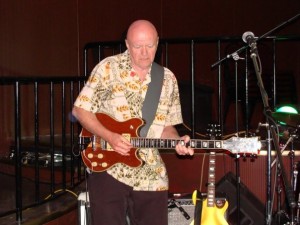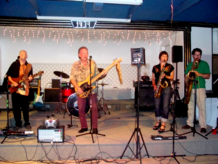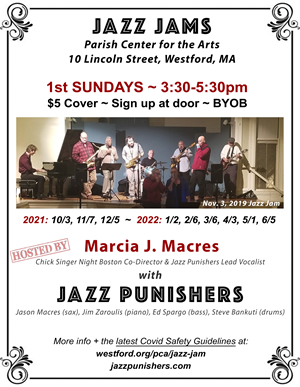 Technology allows musicians to do a lot of things these days. The guitar synthesizer is one tool that lets a guitar player multi-task on stage. Gene Sibley, of the Gene Sibley Group in Dover, New Hampshire, has been working with Roland Guitar Synthesizers for 20 years. “I use a Roland guitar synthesizer and a couple of amps,” he said. “With a couple of amplifiers, I’ve been able to cover piano and strings and horns. I have 460 different instruments in the synth. I use about 25 on a regular basis.”
Technology allows musicians to do a lot of things these days. The guitar synthesizer is one tool that lets a guitar player multi-task on stage. Gene Sibley, of the Gene Sibley Group in Dover, New Hampshire, has been working with Roland Guitar Synthesizers for 20 years. “I use a Roland guitar synthesizer and a couple of amps,” he said. “With a couple of amplifiers, I’ve been able to cover piano and strings and horns. I have 460 different instruments in the synth. I use about 25 on a regular basis.”
A guitar synthesizer basically turns the notes played on the electric guitar into the notes of another instrument. “It takes the signal from the strings and converts it to a digital signal that a synth can read,” Sibley said. “Essentially, it has the internal workings of a keyboard built into a floor pedal. I play guitar through one amp, and I play whatever a keyboard can do through another amp simultaneously.”
“I use two Peavey Bandits,” he said. “You can buy them for a hundred bucks anywhere. They’re lightweight, and they do what I need. Guitar player rules don’t apply to me because I don’t really have that Deluxe Reverb kind of guitar sound. I use a lot of different ingredients.”
Sibley does enjoy the Deluxe Reverb Fender Tube amp when he plays straight guitar. “Their voiced specifically for guitar where the Bandit is a more versatile amp. You can run a bass through it if you have to. It’s like a working man’s practice amp.”
Sibley said it all depends on what kind of music a musician is playing. “If you’re into blues and R&B, (the Fender Tube Amp is) what you use. A lot of metal heads like the Marshalls. They have a different crunch to them. They have an entirely different sound. What makes an amp right for you is what you play and what you want to sound like.”
A true musician never stops learning and improving. Sibley, who’s been playing for 55 years, has been taking advanced guitar lessons for the last 20 years. His guitar instructor, John Rumney, is also the keyboard player for Gene Sibley Group. Rumney, of Rollinsford, New Hampshire, has written text books about harmony and theory.
Sibley can use his Roland to muster the sounds of piano, organ, vibes, saxophone, trombone, banjo, strings, nylon string guitar. “It’s got some big guitar samples in it,” Sibley said. He only needs to step on his Roland GR-20 pedal. His sixth synth pedal, he’s owned it for ten years. Sibley is pretty much on his own when he’s trying to learn how to stretch the synth pedal’s effects.
“There aren’t any places where you can take lessons on guitar synth. Nobody plays it,” he said. “You have to discover it for yourself. As far as a I know, I’m the only guy teaching it. I have a recording studio here in Dover in my basement. I teach a little guitar, a little voice. I do demo recordings for people. I put my own stuff together for the band.”
Currently, Sibley is teaching himself to arrange horn parts, making his Roland a Godsend. He can play the song he wants on guitar; then play bass and drums over it; and finally add the horns, all in his own basement studio. He can give each of his band members a CD of their new songs to learn with each player getting a disc with his or her own instrument turned up.
“With the synthesizer, I can play every instrument in the band,” he said, “so when they come into rehearsal to learn a song I have a CD with their part louder than everybody else’s that I can give them.”
Depending on the song, this process can be long and intricate. Lately, Sibley has been adding horns to an old Vanilla Fudge version of a Supremes song, “My World Is Empty Without You.” Sibley can give the song groove and swagger with his equipment.
Sibley got involved with electronic guitar music 40 years ago, getting the bug in the mid-1960s when he was playing for a living in California, 1965 to 1970. “I started getting into gimmicks and stuff like that,” he said, “hoping that some day somebody would come up with something like this and as soon as they did, I started playing with them. They’d been pretty primitive, but for the last 20 years, they’ve come a long way. I had six different synthesizers. This one’s been with me almost ten years now. It’s great. It’s user friendly. I can take it out on gigs and play it live and not worry about the thing glitching on me.”
 Sibley’s Roland Guitar Synthesizer can actually attach to any guitar. He has six guitars that are set up for Roland synth. A little box called the AD converter(analog to digital) is a pickup that a player installs on the guitar. From there, the signal runs down a wire to a foot pedal which is the other half of the Roland Guitar Synthesizer and then into the amplifiers. Sibley relies on a Carvin TL60, Schecter C1 Classic, Gibson Howard Roberts Custom, Telecaster, Peavey Limited, and a Godin Session.
Sibley’s Roland Guitar Synthesizer can actually attach to any guitar. He has six guitars that are set up for Roland synth. A little box called the AD converter(analog to digital) is a pickup that a player installs on the guitar. From there, the signal runs down a wire to a foot pedal which is the other half of the Roland Guitar Synthesizer and then into the amplifiers. Sibley relies on a Carvin TL60, Schecter C1 Classic, Gibson Howard Roberts Custom, Telecaster, Peavey Limited, and a Godin Session.
“They have different guitar responses,” Sibley said. “Some of them have better sustain. It just depends on what I feel like playing that night. The guitars have different tone characteristics. Generally, I take a second guitar for a backup in case something goes wrong,” he said. “For the most part, I’ll just pick one off the shelf that I like that night and go play it.”
Sibley is the primary vocalist for his Gene Sibley Group. He uses a Blue Encore 200 microphone. For his PA mixer he has a Behringer 2400 with four Mackie C200 ten inch speakers. His DigiTech Vocalist Live 3 allows him to harmonize with himself. Every note he sings comes out in two or three part harmony. He can operate that too with a foot pedal.
Sibley requires simplicity, depending on equipment that is very user friendly. He operates two computers with his feet. “I’ve been going blind slowly for about 50 years,” he said. “I have a disease called Retinitis Pigmentosa, which is basically collapsing tunnel vision. Now I see the world through a hole about the size of a tennis ball. I can look down and see where my foot is and then use that (vision space) to find the microphone when I look back up. I’ve got really good intuitive tools at my feet and I use them to orient myself to the microphones so I can find myself.”
Sibley’s band mates use an Audix OM2 for their mics. “The horn players sing, but not with their mouths full,“ he quipped. Sibley is referring to saxophonists Kat-Lee Newton and Matt Smith. Gene Sibley Group also includes drummer Dan Fishbein, a.k.a. Melvin “Corndog” Fishbone.
There are numerous sound possibilities in Gene Sibley Group. Keyboardist John Rumney can emulate the pedal steel guitar, for example, with his Korg Kaoss, a high end synth that has 600 sounds that work well with Sibley’s Roland Guitar Synthesizer.
“We can orchestrate pretty thoroughly with my horn section,” Sibley said. “We have two horns playing and at the same time we have two synthesizers, so I can be doing guitar, voice, and strings simultaneously while the other keyboard players is doing trombone, trumpet, and guitar. We can get six instruments over and above what the other four guys are doing.”
“We’re an unapologetic bar band,” Sibley said. “If we were to get into a large concert situation where we had to have real serious sound reinforcement, I’d adjust my PA monitor. My audiences are 50 to 100 people. We have to move it in and out of clubs frequently. I need to be able to juggle with speakers and that’s what I like about the Mackies. They’re less than 35 pounds and they can cover a 2,000 square foot room without any problems. That’s bigger than most of the rooms we’re in.”
Sibley and his band mates use Roland Cube monitors to bring the sound back to the stage. Each player has one, and they can turn up the volume and set their own mix and can put three inputs into it. “If you want to hear the bass player better than it’s coming back in the room, you can take a patch off the bass amp and run it into your monitor and turn it up any way you want. We have three of those mounted on poles,” Sibley said.
This weekend, music fans can catch Sibley and his Roland Guitar Synthesizer at Federal Jacks in Kennebunkport, Maine this Friday from 10 p.m. to midnight. On Saturday night, Gene Sibley Group will be at American Legion in Suncook, New Hampshire. Every Monday the drummer, bass player Thom Scagliotti, and Sibley hold an open mic at Castaways Boathouse in Dover, New Hampshire. The trio do six month stints at Castaways before the open mic shuts down for the summer. Castaways has a hundred boat slips so people can come up the Cocheco river and park and party at Castaway’s and crash in their boats.
Gene Sibley Group can be counted on for variety, James Brown, Otis Redding, Wilson Pickett, Willie Nelson, Vanilla Fudge, Warren Zevon, and some original material. “We’re all old guys. I’m 70. The keyboard player’s 65, and then I’ve got three kids in their 50s,” Sibley said.

